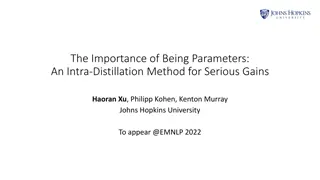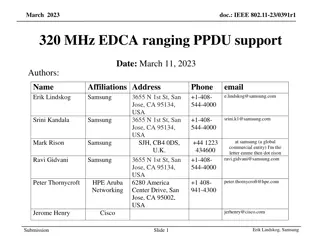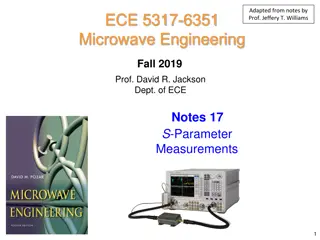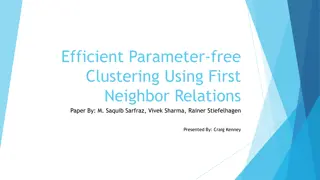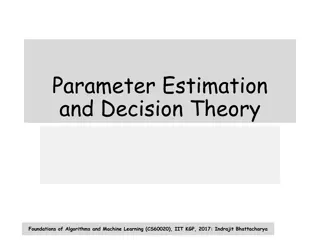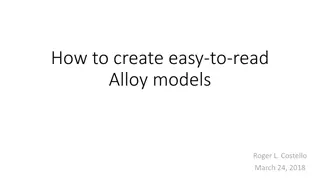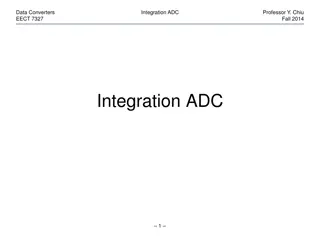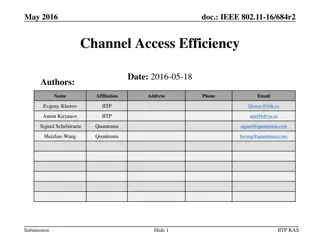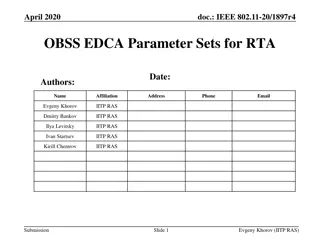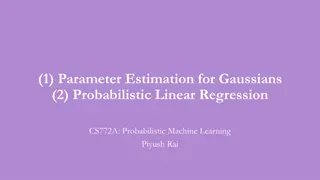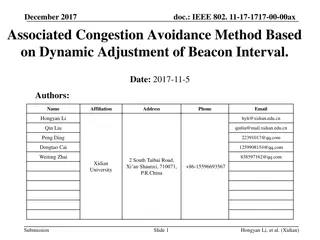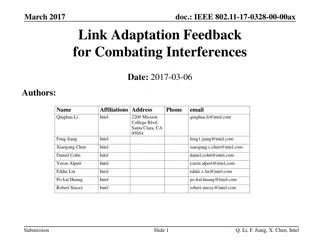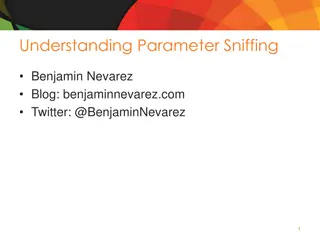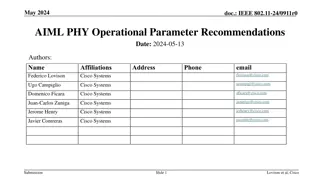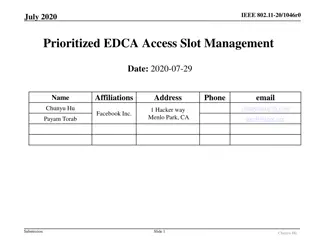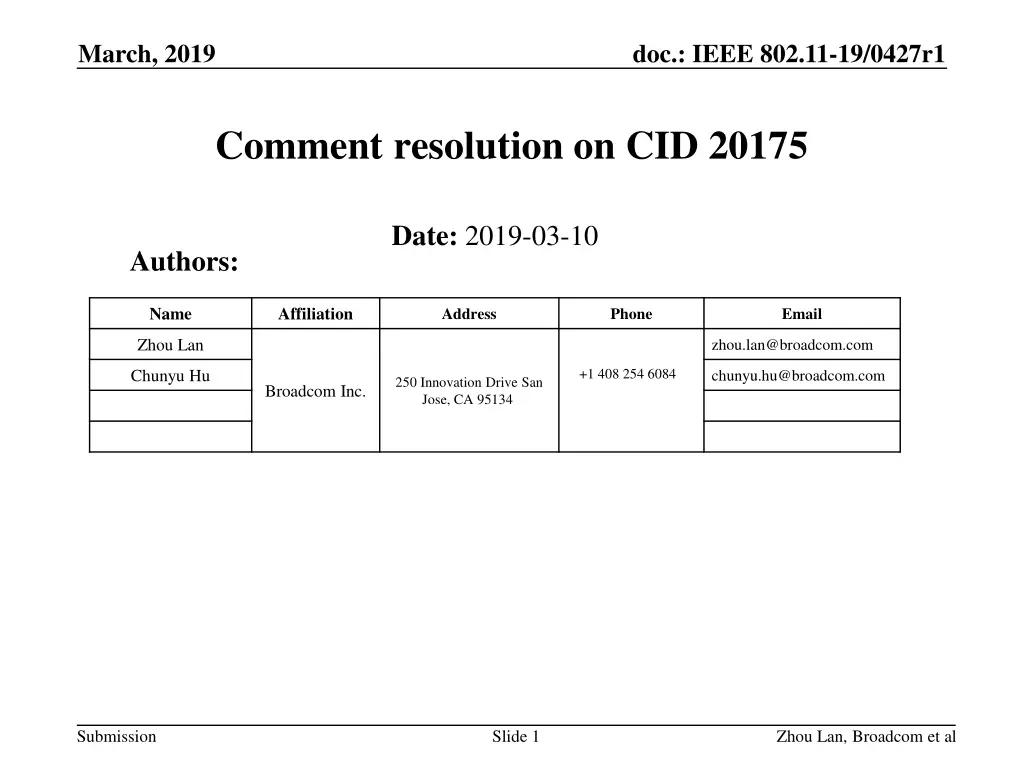
Resolve MU EDCA Backoff Period Issue in IEEE 802.11-19/0427r1
Addressing the lack of signaling mechanism in the MU EDCA procedure to allow APs or non-AP STAs to exit the backoff period when AP triggers stop, preventing delays in UL traffic. Proposed changes aim to define an explicit or implicit signaling mechanism for a smoother transition. Various solutions and challenges are discussed in the document.
Download Presentation

Please find below an Image/Link to download the presentation.
The content on the website is provided AS IS for your information and personal use only. It may not be sold, licensed, or shared on other websites without obtaining consent from the author. If you encounter any issues during the download, it is possible that the publisher has removed the file from their server.
You are allowed to download the files provided on this website for personal or commercial use, subject to the condition that they are used lawfully. All files are the property of their respective owners.
The content on the website is provided AS IS for your information and personal use only. It may not be sold, licensed, or shared on other websites without obtaining consent from the author.
E N D
Presentation Transcript
March, 2019 doc.: IEEE 802.11-19/0427r1 Comment resolution on CID 20175 Date: 2019-03-10 Authors: Name Affiliation Address Phone Email Zhou Lan zhou.lan@broadcom.com +1 408 254 6084 Chunyu Hu chunyu.hu@broadcom.com 250 Innovation Drive San Jose, CA 95134 Broadcom Inc. Submission Slide 1 Zhou Lan, Broadcom et al
March, 2019 doc.: IEEE 802.11-19/0427r1 CID 20175 CID 20175 Commenter Chunyu Hu clause 26.2.7 Resolution Comment The MU EDCA procedure is lack of an explicit or implicit signaling mechanism that allows AP or non-AP STAs to exit current MU EDCA backoff period when AP stops triggering. The lack of the mechanism can cause non-AP STAs' UL traffic being delayed significantly. Proposed Change Define an explicit or implicit signaling mechanism to solve this problem. Revised Agree in principle. Refer to IEEE 802.11-19/0427r0 for discussions TGax editor to make the changes shown in 11-19/xxxr0 Submission Zhou Lan, Broadcom et al Slide 2
March, 2019 doc.: IEEE 802.11-19/0427r1 Background 802.11 AX AP includes MU EDCA Parameter Set element in Beacon and Probe Response frames. MU EDCA parameter sets are defined for one or more ACs, each of which may have different priority, usually lower, with respect to legacy EDCA parameters to favor UL MU transmissions. If an AP has transmitted MU EDCA parameters for a certain AC, the STA that received the MU EDCA parameters switches to use MU EDCA parameters for that AC when the STA receives a Basic Trigger frame and successfully transmits QoS Data frames for the corresponding AC carried in the HE Trigger-based PPDU. The STA uses the MU EDCA parameters for the duration (i.e.Timeout value) defined in the HEMUEDCATimer [AC] field of the MU EDCA Parameters element However, when an AP wants the corresponding STA to terminate the current MU EDCA time out value (<=2s), there is no mechanism defined in the current spec to do so. The STA has to wait for the remaining time to finish without being triggered, during which time the STA cannot shift back to regular EDCA mode Submission Slide 3 Zhou Lan, Broadcom et al
March, 2019 doc.: IEEE 802.11-19/0427r1 Problem Description The following diagram illustrates a scenario where an AP has decided to temporarily stop transmitting triggers. After the AP has stopped transmitting triggers, new traffic arrives at STAs that had been receiving triggers Those STAs continue to use MU-EDCA access parameters and can only revert to normal EDCA parameters after the MU EDCA timeout This creates increased latency which affects latency sensitive applications and RTT measurements used by flow control protocols (e.g. TCP) Submission Slide 4 Zhou Lan, Broadcom et al
March, 2019 doc.: IEEE 802.11-19/0427r1 Possible Solutions to the Problem Reduce MU EDCA time-out value This might not be possible The AP selects the timeout value based on its estimate of DL and UL network load The AP may need to interleave DL and UL transmission/scheduling The AP might have many active links involved in UL OFDMA It might take a long time to service all STAs Hence the need for a large MU-EDCA time-out MU EDCA time-out value is broadcast in Beacons and it takes a few Beacons to update This makes on-the-fly MU EDCA parameter modification challenging Traffic and links are dynamic Beacon update method makes MU EDCA parameter changing at fine time granularity (e.g. tens of ms) challenging Introduce policy to allow STAs to send QoS-Null to request AP to schedule UL STA UL traffic can interfere with AP s scheduled traffic, either DL or UL. Causes increased congestion AP sends UORA before stopping current UL OFDMA trigger transmissions UORA is an optional feature Needs AP to continue transmitting one or more triggers for STA to count down OBO To ensure that all STAs have had a chance to respond Submission Slide 5 Zhou Lan, Broadcom et al
March, 2019 doc.: IEEE 802.11-19/0427r1 Proposal Mechanism-1: AP signals all receiving STA(s) to terminate their current MU- EDCA time-out count using A-control field Send a QoS Null frame that carries A-Control instructing the receiving STA(s) to terminate their current MU EDCA time-out count Trigger frame (e.g. new trigger type, utilize trigger reserved bit etc) Broadcast RA, all receivers obey the bit HE action frame Submission Slide 6 Zhou Lan, Broadcom et al
March, 2019 doc.: IEEE 802.11-19/0427r1 Straw Poll SP1: Do you accept one of the following signaling method for the AP to terminate the current MU EDCA time-out at the STAs Option 1: A-Control Option 2: Trigger frame Option 3: HE action frame Option 4: non of the above Submission Slide 7 Zhou Lan, Broadcom et al
March, 2019 doc.: IEEE 802.11-19/0427r1 Open Discussion Mechanism-2: have an inactivity detection and time-out mechanisms Detection mechanism How to detect the inactivity on the AP side Utilize BSS color and address fields? How to differentiate the inactivity from OBSS BSS color, Partial AID? How to deal with frames that has high rates that can not be decoded by the STA Utilize preamble information? Trigger condition to exit from the current MU EDCA Time-out If a STA in MU-EDCA mode observes AP not initiating any transmission (RTS, DATA) for this time-out value, then STAs in MU-EDCA mode can switch to regular EDCA mode Suggest such a time-out value to be at least 2-3 maximum PPDU duration to give AP multiple opportunities to finish ongoing transmission(s) and next trigger(s) If a STA in MU-EDCA mode observes AP not transmitting Trigger frames addressed to it for the time-out value, then the STA in MU-EDCA mode can switch to regular EDCA mode Open for discussions and suggestions Submission Slide 8 Zhou Lan, Broadcom et al
March, 2019 doc.: IEEE 802.11-19/0427r1 Straw Poll SP2: Do you agree to consider one of the following inactivity detection and time-out mechanisms for the STA to exit from the current MU EDCA time-out Option 1: A STA may exit from MU EDCA Time-out if it has observed no frame transmitted by AP during a newly defined inactivity time out period Option 2: A STA may exit from MU EDCA Time-out if it has observed no Trigger Frames transmission addressed to it during a time out period Option 3: non of the above Submission Slide 9 Zhou Lan, Broadcom et al

